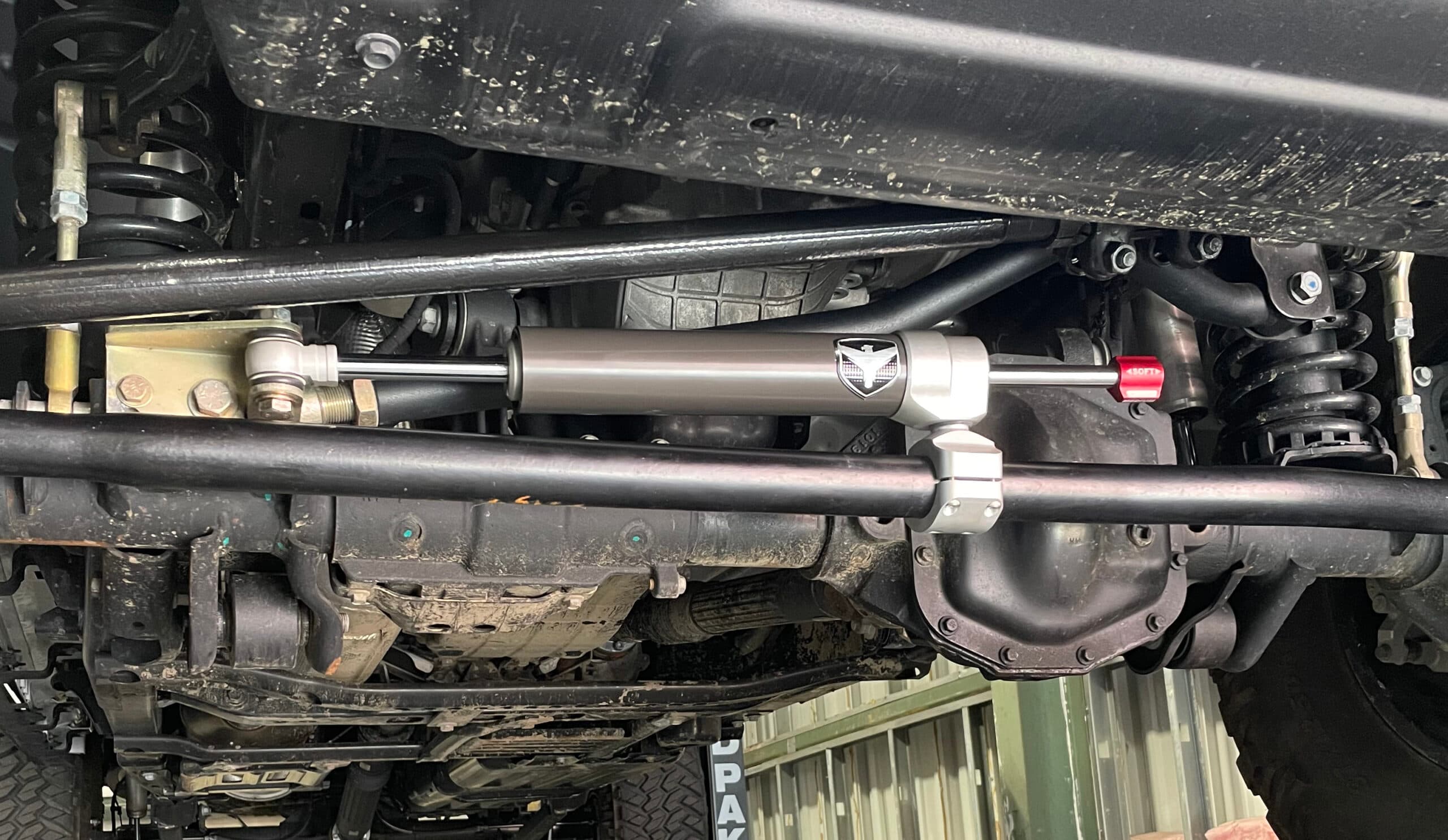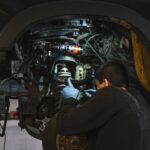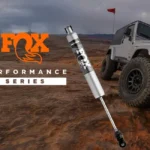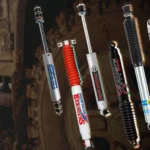
What does steering stabilizer do in an off-road vehicle? How is it related to death wobble?
What is the purpose of a steering stabilizer (steering damper) in an off-road vehicle, how does it impact the steering system, and does it have anything to do with the dreaded “death wobble”? We debunk myths and explain how to choose the right steering damper when modifying your car.
What is a steering stabilizer and which cars have it?
A steering stabilizer is most commonly found in vehicles with a solid front axle, supported by coil springs in short, cars with a dependent suspension. It’s placed horizontally between the front wheels. Even though it operates similarly to standard suspension shocks, its function is different. Instead of dampening vertical movements, the steering stabilizer reduces sideways vibrations between the wheels.
What about cars with leaf springs? In most off-road vehicles with leaf spring suspension, a steering stabilizer isn’t necessary. This is because leaf springs already stabilize the vehicle by connecting the axle to the body in four points. However, some vehicles, like the Jeep Wagoneer and older models such as the Samurai, combine leaf springs with a steering stabilizer for added stability.
What is the steering stabilizer’s role in off-road vehicles?
The main job of a steering stabilizer is to support the steering system, making it easier to control the vehicle. This helps reduce “bump steer,” which refers to uncontrolled steering movements that can jerk the steering wheel out of the driver’s hands. Additionally, steering damper minimizes the impact of bumps and uneven terrain on the steering wheel.
Steering stabilizer adds some resistance to steering, especially at low speeds, it also helps the steering wheel return to its neutral position. This makes the steering of the off-road vehicle more stable and easier for the driver to manage.
In the end, the steering damper makes the steering system more predictable, which increases safety and comfort when driving over rough terrain – an essential aspect of off-roading. Additionally, it positively affects the durability of steering components, such as ball joints. Therefore, it’s important not to blame steerinf damper for problems it doesn’t cause.
Should you replace the steering damper and why?
In most off-road vehicles with coil spring suspensions, the steering stabilizer is a factory-installed part. This raises the question: why is it such an important component in off-roading, and why should you consider replacing it even if the original one is still functioning.
The answer is simple. The factory steering stabilizer is designed to work with the vehicle’s original steering system as it came from the dealership. It performs well within that specific setup. Its durability is also estimated to be around 80,000 km under normal driving on paved roads. However, if you start modifying your vehicle – especially by upgrading to larger wheels – the original steering stabilizer may struggle to keep up.
Larger wheels and tires add more weight to control, making the steering system work harder, particularly in tough off-road conditions. It’s like trying to run a mountain race in sandals – it’s possible, but far from ideal.
Types of 4×4 steering stabilizers
Now that you know the steering stabilizer’s role and the benefits of upgrading, let’s look at the different types available. They all work slightly differently and offer unique handling experiences.
Oil Steering Stabilizer
This is a type of stabilizer from an older technology. It has a simple design, which makes it more durable against damage. Additionally, it is inexpensive to buy and maintain. The way the stabilizer works can be described as smooth and linear, providing consistent resistance along the entire length of the piston. When installing new wheels that are about 2 sizes larger than the original ones, replacing the steering stabilizer with a better type of oil steering damper will be sufficient.
Gas or Gasoil, Hybrid Steering Stabilizer
This is a type of newer design that uses pressurized gas (nitrogen) to provide better performance that isn’t affected by conditions, duration of use, or temperature. However, it is more prone to damage and is more delicate, so if the gas leaks, the stabilizer stops working immediately.
Installing this type of damper is recommended when replacing wheels with much larger ones. However, if you stick with the factory size wheels, it will result in a stiffer, sportier driving feel.
Dual Steering Stabilizer
This setup uses two steering stabilizers, usually gas-type, connected together and placed on opposite sides. They help reduce the steering wheel’s bouncing effect by evenly distributing the force acting on the wheels. While this configuration can make steering feel slightly heavier, it is especially recommended for off-road vehicles with larger wheels, such as a Jeep running 37-inch tires or bigger.
Steering Stabilizer with Thru Shaft Technology
The Thru Shaft steering stabilizer is currently the most advanced design. It features a through-shaft, meaning the shaft remains the same length inside the stabilizer while the piston moves along with it. This design eliminates the issue of oil displacement.
This smooth operation ensures consistent steering performance, absorbs vibrations, and prevents the wheels from being pushed to one side. As a result, the Thru Shaft steering damper performs well in all condition, for any application, and with any wheel size.
Thru Shaft Steering Stabilizer with Reservoir
It’s worth mentioning that among Thru Shaft stabilizers, there are also models with a reservoir. The reservoir contains an oil column, and a nitrogen chamber separated by an IFP piston. This type of steering damper is especially useful during demanding work, when it is heavily used for long periods, putting its performance to the test. It helps eliminate the negative effects of oil expansion due to heat during intense use.
How Much Does a Steering Stabilizer Cost and Which One Should You Choose?
Steering stabilizers typically range in price from around 100 EUR to several thousand EUR, depending on the type and manufacturer. If you’re gearing up for serious off-roading, replacing the steering stabilizer will be one of your first upgrades right after tires and suspension.
The most expensive and effective options on the market are dual steering stabilizers and Thru-Shaft ones, especially with an added reservoir. These are recommended for vehicles with large tires and high suspension lifts.
Additionally, more expensive models include steering stabilizers with multi-stage stiffness adjustment. This is especially a good investment if your off-road vehicle is used both for everyday driving and off-road adventures. A stiffer stabilizer will provide more stability when driving on asphalt. On the other hand, a softer setting allows for more flexibility, making it less sensitive to wheel impacts and improving stability when driving off-road.














Comments ()